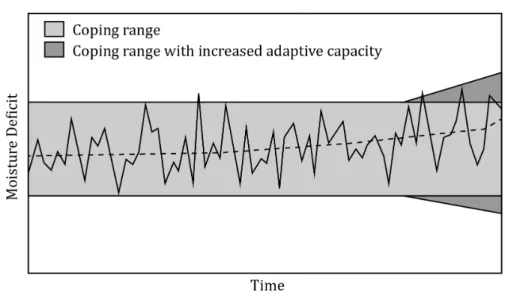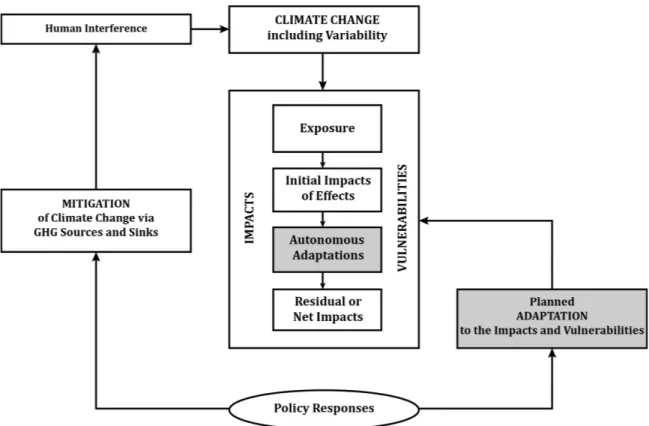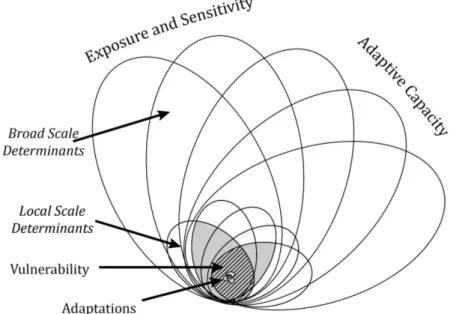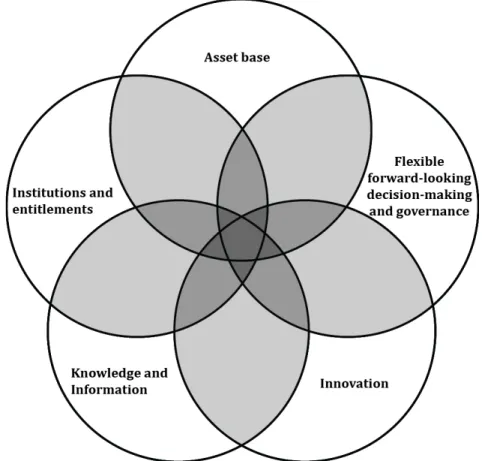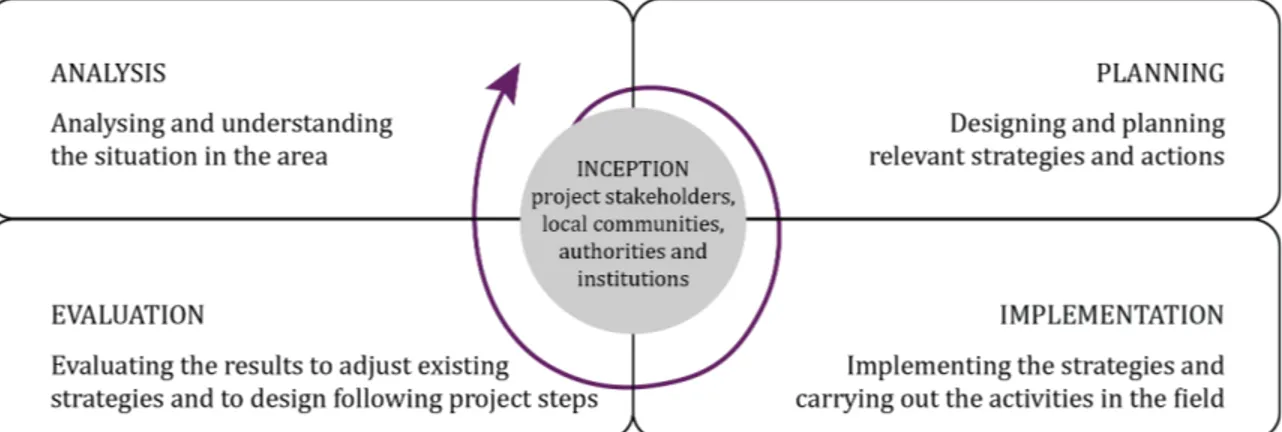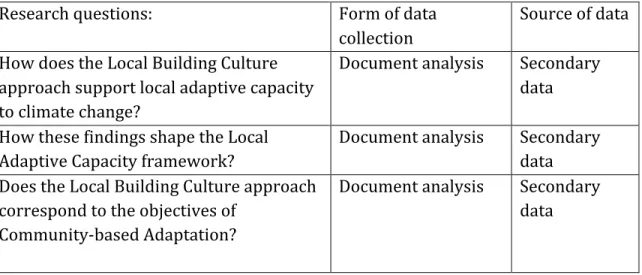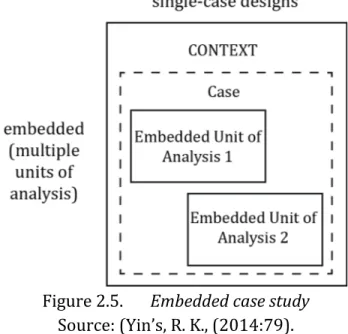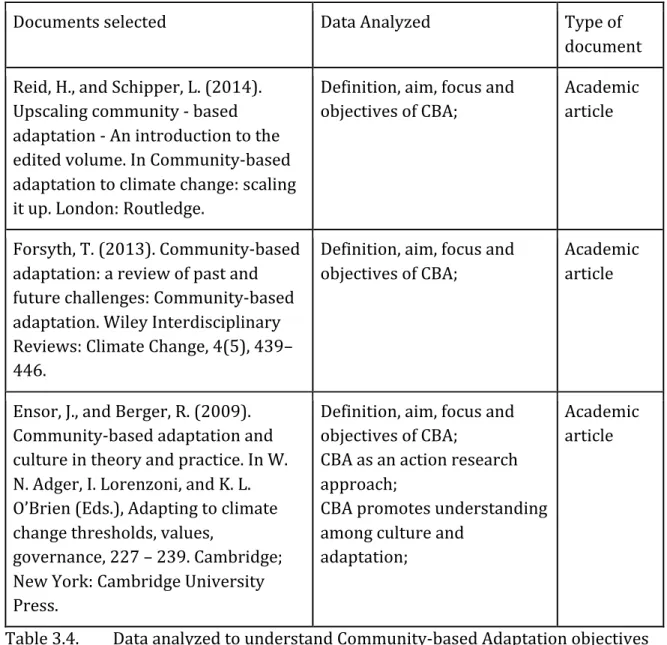HAL Id: dumas-01419511
https://dumas.ccsd.cnrs.fr/dumas-01419511
Submitted on 19 Dec 2016
HAL is a multi-disciplinary open access
archive for the deposit and dissemination of sci-entific research documents, whether they are pub-lished or not. The documents may come from teaching and research institutions in France or abroad, or from public or private research centers.
L’archive ouverte pluridisciplinaire HAL, est destinée au dépôt et à la diffusion de documents scientifiques de niveau recherche, publiés ou non, émanant des établissements d’enseignement et de recherche français ou étrangers, des laboratoires publics ou privés.
The effects of the local building culture approach on the
local adaptive capacity to climate change: the case of
the implemented project in Haiti
Vuk Marković
To cite this version:
Vuk Marković. The effects of the local building culture approach on the local adaptive capacity to climate change: the case of the implemented project in Haiti. Architecture, space management. 2016. �dumas-01419511�
The effects of the local building culture approach
on the local adaptive capacity to climate change:
The case of the implemented project in Haiti
Vuk MARKOVIĆ ID 21528972 M.Sc. Urbanism, Habitat and International Cooperation Institut dćUrbanisme de Grenoble -‐ Université Grenoble Alpes 08th of September, 2016 Supervisor: Prof. Dr. Jean-‐Christophe Dissart
Jury member: Dr. Nebojša Čamprag
NOTICE ANALYTIQUE PROJET DE FIN D’ETUDES
Nom et prénom de l’auteur: Vuk MARKOVIĆ (Étudiant) Titre du projet de fin d’études:
The effects of the local building culture approach on the local adaptive capacity to climate change: The case of the implemented project in Haiti
Date de soutenance: 08th of September, 2016
Organisme d’affiliation: Institut d’Urbanisme de Grenoble -‐ Université Grenoble Alpes
Directeur du projet de fin d’études: Prof. Dr. Jean-‐Christophe Dissart
Collation:
-‐ Nombre de pages: 67
-‐ Nombre de références bibliographiques: 26 (Tout type de documents sur tout type de support)
Résumé en Français et dans une langue étrangère de votre choix:
Abstract:
Climate change is a certain truth. Adapting to climate change becomes a necessity. The 2015 Paris agreement on climate change sets the global adaptation goal, with the aim to increase adaptive capacity to climate change. Many development approaches are not designed as adaptation interventions, but they have an impact on adaptive capacity. The aim of this thesis is to evaluate the impact of the Local Building Culture (LBC) approach on the local adaptive capacity. The evaluation is based on the implemented project in Haiti, and it follows a descriptive framework. Evaluating this impact brings new understandings on the LBC approach in the context of climate change adaptation. It is expected that the LBC approach positively affects the local adaptive capacity, since it is based on a local know-‐how and expertise, actively involving local stakeholders in the development process. On a broad scale research illustrates a model of evaluating an impact of development approaches on adaptive capacity, which brings potential for its characterization and adjustments of development interventions in the context of climate change.
Keywords: climate change adaptation, local adaptive capacity, community-‐based adaptation, local building
culture, and vulnerability;
Résumé:
Le changement climatique est une « est un fait avéré ». L'adaptation au changement climatique devient une nécessité. L'accord de Paris 2015 sur le changement climatique définit l'objectif global d'adaptation dans le but d'accroître la capacité d'adaptation au changement climatique. De nombreuses approches de développement ne sont pas conçues comme des interventions d'adaptation, mais elles ont pourtant un impact sur la capacité d'adaptation. L'objectif de ce mémoire est d'évaluer l'impact de l'approche des Cultures Constructives Locales (CCL) sur la capacité d'adaptation locale. L'évaluation est basée sur un projet mis en œuvre en Haïti et elle suit un cadre descriptif. L'évaluation de cet impact apporte de nouvelles connaissances sur l'approche CCL dans le contexte de l’adaptation au changement climatique. Il est pressenti que l'approche CCL impacte positivement la capacité d'adaptation locale, car elle est fondée sur des expertises et des savoir-‐faire locaux en impliquant activement les acteurs locaux dans le processus de développement. Dans une perspective plus générale cette recherche illustre un modèle d'évaluation d'impact d’approches de développement sur la capacité d'adaptation. Cela apporte un potentiel pour sa caractérisation et pour proposer des ajustements aux interventions de développement dans le contexte du changement climatique.
Mots-‐clés: adaptation au changement climatique, capacité locale d'adaptation, adaptation à base
communautaire, cultures constructives locales, vulnérabilité;
Acknowledgements
Supervisor
I would like to thank to my thesis supervisor Prof. Dr. Jean-‐Christophe Dissart, for all the support, and methodic guidance throughout the work on thesis. Thank you.
CRAterre and LabEx AE&CC
I would like to thank to the CRAterre institute and LabEx AE&CC for the support and opportunity to be part of the team. Special thanks goes to my internship mentor Philipe Garnier, for all the commitment and inspiration.
Mundus Urbano
I would like to thank to Mundus Urbano Consortium, for the support and
organization of the master programme. Special thanks goes to my Mundus Urbano colleagues and friends from all around the world. You were true inspiration
throughout this journey.
Family
Last but not least, gratitude goes to my lovely family for the enduring support and love that they expressed all these years. Hvala vam na neizmjernoj podršci i ljubavi. Volim vas.
Table of Contents:
Chapter 1: Introduction 6
1.1. Background 6
1.2. Definition of terms and concepts 7
1.3. Statement of the problem 7
1.4. Purpose of the research 8
1.5. Significance of the research 8
1.6. Scope and limitation 8
1.7. Description of the thesis chapters 9
Chapter 2: Literature review 10
2.1. What is climate change adaptation? 10
2.2. Adaptive capacity to climate change 16
2.3. Community-‐based Adaptation 25
2.4. Local Building Culture approach 28
2.5. Conclusion 32
Chapter 3: Methodology of research 34
3.1. Introduction 34
3.2. Purpose of the study 34
3.3. Research design 35
3.4. Data collection 36
3.5. Limitations and strengths of the research 41
Chapter 4: Analysis and Findings 43
4.1. Part I -‐ Document analysis: Reconstruction project in Haiti 43
4.1.1. Analysis of the context 43
4.1.2. Reconstruction projects in Haiti 44
ReparH Research project 44
EPPMPH 45
ENH-‐PRESTEN project 47
GADRU project 47
CONCERT-‐ACTION project 48
VEDEK project 49
EdM – ‘Entrepreneurs du Monde’ project 49
UN Habitat training programme 50
4.1.3. Philosophy and approach of the reconstruction of Haiti 50 4.1.4. Methodology of the analysis of the local building cultures 51
4.2. Findings 52
4.2.2. Institutions and entitlements 55
4.2.3. Knowledge and Information 56
4.2.4. Innovation 57
4.2.5. Flexible, forward-‐looking decision-‐making and governance 58
4.3. How these findings contribute to the LAC framework? 58
4.4. Part II – Does the Local Building Culture approach correspond to the objectives of the Community-‐based Adaptation?
4.4.1. Analysis 60
4.4.2. Findings 60
Chapter 5: Discussion and conclusion 62
5.1. Conclusions on the research questions 62
5.2. The importance of research and future recommendations 63
5.3. Conclusion 63
Bibliography 65
Chapter 1: Introduction
1.1. Background
Today, climate change is a certain truth. The fourth report of the Intergovernmental Panel on Climate Change (IPCC) shows that the climate is changing (IPCC 2007 a,b as quoted in Lemos, et al., 2007:1), which will bring higher frequency and intensity of natural disasters, the climate variability will be less predictable and there is an uncertainty about the impacts of the changes (Lemos, et al., 2007).
Impacts of climate change are experienced differently around the world. Developing countries are severely affected, which brings another layer of development
challenges. The notion of uncertainty about climate change gives no possibility to predict the impacts. Development strategies need to respond to these challenges by targeting specific vulnerable groups, and enhancing their capacity to respond to the impacts.
Adapting to climate change, as the ability of a system (e.g. community) to respond to changes, is becoming an important part of development strategies. In 2015 the Paris agreement on climate change was signed during the Conference of Parties 21
(COP21). The agreement shows the importance of taking climate change adaptation into account in reaching sustainability and resilience, since the climate change mitigation is not enough (Heltberg et. al., 2009). According to the Article 7 of the Paris agreement, which is legally binding document to the UN member countries, the global goal of adaptation is “enhancing adaptive capacity, strengthening resilience and reducing vulnerability”, which will contribute to sustainable development in the context of climate change global goal, which is keeping the increase of the global temperature “well below 2 degrees Celsius” (UNFCCC, 2016).
In other words, climate change adaptation needs to be mainstreamed in the
development strategies. According to the Saleemul Huq and Hannah Reld (2004) the adaptation to climate change is “fundamentally linked to development” (Huq & Reid, 2004:16). These linkages exist on different scales, levels (local, sectoral, national, regional, global).
Many development interventions are not designed as the adaptation to climate change. However, findings show that these approaches have an impact on adaptive capacity to climate change. Exploring this impact brings new perspectives in the context of climate change adaptation and adjustments of development activities to respond to climate impacts on a long-‐term.
In this sense, the aim of this thesis is to evaluate the impact of the Local Building Culture (LBC) development approach on the local adaptive capacity. The evaluation is based on the implemented project in Haiti. It is expected that the LBC approach positively affect local adaptive capacity, since it is based on a local know-‐how and expertise, including local stakeholders in the development process.
1.2. Definition of the terms and concepts
Climate change adaptation refers to the “adjustments in ecological, social, or
economic systems in response to actual or expected climatic stimuli and their effects or impacts” (Smit and Pilifosova, 2003:879). The adjustment “refers to changes in processes, practices, or structures”, which will neutralize or take advantage of expected impacts of climate change (Smit and Pilifosova, 2003:879).
Adaptive capacity “refers to the potential, capability, or ability of a system to adapt to climate change stimuli or their effects or impacts” (Smit and Pilifosova,
2003:894).
Community-‐based adaptation (CBA) is defined “as a process focused on those communities that are most vulnerable to climate change” (Huq and Reid, 2007 as quoted in Ensor and Berger, 2009:231). The process is “is rooted in the local context and requires those working with communities to engage with indigenous capacities, knowledge and practices of coping with past and present climate-‐related hazards” (Ensor and Berger, 2009:231).
Local Building Culture (LBC) is the approach that focuses on improving local habitat and community resilience by identifying local knowledge and know-‐how related to traditional ways of building. The approach is based on the principle of active participation of a community, delivering the ownership of the project and meeting the needs of the people.
1.3. Statement of the problem
Many development approaches are not designed as adaptation interventions, but they have an impact on adaptive capacity. Mainstreaming climate change adaptation into development requires an understanding of these development practices and the ways they impact the local adaptive capacity. This will provide new
opportunities for adjusting development activities in responding to climate change challenges.
1.4. Purpose of the research
The aim of the study is to evaluate LBC approach, through a chosen descriptive framework, and answer how does this approach support local adaptive capacity to climate change.
The hypothesis is that LBC positively impacts the local adaptive capacity. Based on the findings, adaptive capacity is ‘intimately’ connected with the climate change adaptation. The second research question derives from the first. The aim is to understand does objectives of the LBC approach correspond to the Community-‐ based Adaptation, described in the literature review.
To reach the aim of the thesis, research questions are set to guide the research process, and they are state as follow:
1. How does the Local Building Culture approach support local adaptive capacity to climate change?
• How these findings shape the Local Adaptive Capacity framework? 2. Does the Local Building Culture approach correspond to the objectives of
Community-‐based Adaptation?
1.5. Significance of the research
Evaluating Local Building Culture provides an overview on how locally based development intervention shape the adaptive capacity. On a broad scale research illustrates a model of evaluating an impact of development approaches on adaptive capacity, which brings potential for its characterization and adjustments of
development interventions in the context of climate change.
1.6. Scope and limitation
The research method is based on the analysis of the relevant documents, which provides the context of the research and base for evaluating the LBC approach. The approach is evaluated through chosen descriptive framework. The methodological paradigm of research is evaluative, and main qualitative method for data collection is document analysis.
The limitations of the research method are related to the inherent limitations of the document analysis, but due to the chosen framework for evaluation and collected data, this method is chosen as the appropriate one to answer the research question.
1.7. Description of the thesis chapters
The Chapter 1 describes the background, problem, purpose, significance, and scope and limitation of the research. This chapter is an introduction to the master thesis.
In the Chapter 2 the literature review examines the concepts of climate change adaptation, adaptive capacity and its different framings, Community-‐based
Adaptation and Local Building Culture approach. The collected information is a base for the understanding of the context of research. Climate change adaptation and adaptive capacity literature are used to answer the first research question, while the analysis of the Community-‐based adaptation and Local Building Culture are used to answer to the second research question.
The Chapter 3 describes methodology of the research. Purpose of the study, research design, data collection and research limitations and strengths are highlighted. The document analysis is the main qualitative method for data
collection. There are inherent limitations to this method, which are explained in the Chapter. Certain models from case study design are taken for the data analysis. This chapter ends with the limitations and strengths of the research.
The Chapter 4 starts with the analysis of the case project in Haiti. Results of the implemented projects are presented, with the philosophy and methodology of the approach in Haiti. The data on Haiti are used for the answer on the first research question. Collected data are presented in the Findings through descriptive framework in visual and textual form. This chapter continues with analysis and findings for the sub-‐question. The Chapter 4 ends with the second research question findings, which are based on the documents analysis from the literature review.
In the final Chapter 5, responses to the research questions are presented with the final remarks and conclusion.
Chapter 2: Literature review
2.1. What is climate change adaptation?
“In very simple terms, adaptation entails an adjustment to changing conditions” (Adger et. al., 2009:10)
Understanding the concept of adaptation
Smit and Wandel (2006) give an overview of the adaptation concept and its treatment in different fields. The term derives from the natural sciences and evolutionary biology, where it refers to the ability of organisms to adapt to the environment in order to survive and reproduce. Organisms have developed “genetic and behavioral characteristics”, which helps them to develop adaptive aspects necessary for survival. These are adaptive features of individual organisms (Smit and Wandel, 2006:283).
As the authors explain, by applying adaptation in human systems anthropologist Julian Steward used the term “cultural adaptation” to describe an adjustment of people to the natural environment with livelihood activities. The other authors dealing with adaptation in human systems define it as a “process of change in response to a change in physical environment or a change in internal stimuli, such as demography, economics and organization” (Denevan, 1983:401 as quoted in Smit and Wandel, 2006:283). This definition expresses different dimensions upon which human systems adapt, dimensions that go beyond physical environment. Also it describes adaptation as a process in time and space.
In social sciences, anthropologists and archeologists use adaptation in terms of an accomplishment of culture to survive. Being able to develop various cultural practices, as a result of a reaction on different abnormalities, group is able to overcome a stress. In terms of natural sciences, cultural practice has genetic character, meaning that the groups without appropriate cultural practices will not be able to benefit from the natural environment, and will not be able to endure. Cultural practices developed as an answer to a stress can be called adaptations. In this way the distinction is made between adaptations of a group and adaptive features of individual organism (O’Brien and Holland, 1992, as quoted in Smit and Wandel, 2006).
As Smit and Wandel (2006) continue, cultural practices, as used in more recent social sciences literature, enable societies to survive. Societies react to different
situations, not just to environmental stresses. Cultures which are capable to react and respond to a new conditions efficiently are considered as cultures with high “adaptability” or “capacity to adapt” (Denevan, 1983 as quoted in Smit and Wandel, 2006).
In the field of climate change, research on adaptation became important with the spreading awareness of the subject of climate change (Smit and Wandel, 2006).
Climate change adaptation
The concept of adaptation in the context of climate change refers to the
“adjustments in ecological, social, or economic systems in response to actual or expected climatic stimuli and their effects or impacts” (Smit and Pilifosova,
2003:879). The adjustment “refers to changes in processes, practices, or structures”, which will neutralize or take advantage of expected impacts of climate change (Smit and Pilifosova, 2003:879).
“Adaptation refers both to the process of adapting and to the condition of being adapted” (Smit and Pilifosova, 2003:882). Process of adapting involves making a change in practices, which will at the end neutralize the adverse effects of climate change (Smit and Pilifosova, 2003).
Either as the process or condition, “adaptation is a relative term”, which “involves an alteration in something (the system of interest, activity, sector, community, or region) to something (the climate related stress or stimulus)” (Smit and Pilifosova, 2003:882).
Climate stimuli
Climate is defined as a pattern of weather for a long period of time (NASA, 2016), or in other words “long term averages and variations” (NOAA, 2016). Climate is
associated with inherent variability and extremes of climatic conditions. Climate change on the other hand is defined as a “change in the state of the climate that can be identified (e.g. using statistical tests) by changes in the mean and/or the
variability of its properties, and that persists for an extended period” (IPCC, 2016). The climate change includes changes caused by climate variability or human activity.
In this sense, as the authors to Smit and Pilofosova (2003) claim, the climate stimuli of adaptation encompass not just changes of averages (annual conditions), referred
as climate change, but also climate variability and extremes of climatic conditions (Smit and Pilifosova, 2003). Why is this important? The systems (eg. community) are adapted to the variability and climate extremes. It is in the system’s coping range to adapt to the long-‐term climate pattern. The problem with changes begins when the extreme events change their long-‐term frequency of occurrence. In those situations extremes are out of the established coping range of the community, which makes them more vulnerable (Smit and Pilifosova, 2003).
The ability to adapt to climate variability, or the yearly climatic conditions, is referred as coping range. In the Figure 2.1., the coping range is shaded, and it is noticeable that it is not static (Smit and Pilifosova, 2003). What the different
fluctuations show are the new adaptations of the system. It illustrate that the coping ranges are “flexible and respond to changes in economic, social, political and
institutional conditions over time” (Smit and Wandel, 2006:287).
Figure 2.1. Coping range and extreme events
Source: (Smit and Wandel, 2006:287).
The decrease and increase of the coping range is different over time. The reasons can be various. For example, economic stability can increase the adaptive capacity to changes, while the natural disasters or the external socio-‐political factors can
decrease the coping range to react. Even the conditions, which are inside the coping range, can act in a decreasing way. If the floods or droughts are repetitive in years, even though their single effect is within coping range of the community, it can bring a negative decreasing trend to the community’s ability to react. Also, one extreme event can be way out the coping range, without a chance for a community to recover, which can “permanently alter” the community’s coping range (Smit and Wandel, 2006:287).
According to the Smit and Pilifosova, (2003) and Smit and Wandel, (2006), the coping range expressed in the Figure 2.1. can be referred as the adaptive capacity of the system, (e.g. community), to respond to changes. Coping range is one of the ways that adaptive capacity is being analyzed (Smit and Wandel, 2006). The issues with the adaptive capacity and its assessment will be explained later in the text.
To outline climate change adaptation process, specific attention is given to the to “who or what adapts, the stimulus for which the adaptation is undertaken, and the process and form it takes” (Smit and Pilifosova, 2003:882).
Climate Change Adaptation Types
Numerous attributes define variety of adaptation types. Most common ones are dividing adaptation based on the purpose, such as autonomous and planned. Also, adaptations can be based on time, such as short or long term adaptations or
localized and widespread (Smit and Pilifosova, 2003). For the purpose of this master thesis, simple explanation of the autonomous and planned adaptation is used as a starting point for the second research question. The community-‐based adaptation, as a form of planned adaptation, will be explained later in the text, in the second part of the literature review.
The autonomous adaptation is usually occurring in unmanaged natural systems. It is referred as reactive adaptation, which means that the reaction on climate stimuli is after its impact. Smit and Pilifosova (2003) talk about adaptations implemented in the human systems, such as community, where private actors, without interference of public domain, lead autonomous adaptations. Opposite of autonomous is planned adaptation, which can be reactive or anticipated, meaning that the adaptation is started before the impact occurred. Planned adaptation is result of defined policy, where public institution is approving planned adaptation strategy based on expected climate changes (Smit and Pilifosova, 2003).
Figure 2.2. Places of adaptation in the climate change issue
Source: (Smit and Pilifosova, 2003:881).
The Figure 2.2. illustrates where the autonomous and planned adaptation are occurring, in the process of climate change adaptation. The impacts and
vulnerabilities of a system (e.g. community) depend on the exposure, initial effects, and the ability of the system to respond, which will be further elaborated. According to the Figure 2.2. planned adaptation options require analysis of the “likelihood of autonomous adaptation” (Smit and Pilifosova, 2003:881).
Purpose of the research of climate change adaptation
In their article, Smith and Wandel (2006) define four purposes of research of climate change adaptation. The common purpose is related to the modeled climate change scenarios. In this case, the adaptation is “assumed or hypothetical, and their effects on the system of interest is estimated relative to the estimated impacts (e.g. in terms of costs, savings, etc)” (Smit and Wandel, 2006:284). The purpose of this research is to assess the impact of climate change, based on a given scenario, without empirical research on adaptation or adaptive capacity. In this sense the “focus is on the effect of the assumed adaptations” (Smit and Wandel, 2006:284).
Second purpose tackles the specific adaptation measures and options, with purpose to define, which adaptation measure is better. The research takes a list of possible adaptations delivered by researchers through models, scenarios, and hypotheses and evaluates them based on similar criteria. The research does not explore the process of adaptations. It only ranks the different options by their efficiency (Smit and Wandel, 2006).
Third scholarship deals with the relative adaptive capacity of countries,
communities, regions, and “involves comparative evaluation or rating based on criteria, indices and variables typically selected by the researcher (Smit and Wandel, 2006:285).
Fourth group of studies relates to the “practical adaptation initiatives” and their analysis. It focuses on the initiatives, which are not “labeled as adaptation”. The aim is to “investigate the adaptive capacity and adaptive needs in a particular region or community in order to identify means of implementing adaptation initiatives or enhancing adaptive capacity” (Smit and Wandel, 2006:285). The focus of this research is to identify the means with which communities already adapt to climate changes and to document decision-‐making process, with assumption that will bring perspectives on the types of adaption and ways of improving adaptive capacity (Smit and Pilifosova, 2003).
Based on the findings, Smit and Wandel (2006) define the features that characterize practical adaptation interventions: (1) The interventions are set to meet the needs of a community; (2) The proposals for interventions are not based on the external researchers data; (3) The interventions use local knowledge and experience; (4) The interventions are based on a local decision-‐making process, upon which,
adaptations are integrated (Smit and Wandel, 2006).
The nature of the practical adaptation interventions is to identify “what can be done in a practical sense, in what way and by whom” (Smit and Wandel, 2006:285), in order to impact the vulnerability of a community.
This master thesis fits under the fourth group of studies, since it investigates how certain development approach, in this case Local Building Culture, supports local adaptive capacity to climate change. The research methodology is described in the Chapter 3.
2.2 Adaptive capacity to climate change.
“Adaptations are manifestations of adaptive capacity, and they represent ways of reducing vulnerability” (Smit and Wandel, 2006:286).
“Adaptive capacity is a vector of resources and assets that represent the asset base from which adaptation actions and investments can be made” (Adger and Vincent, 2005:400).
Adaptation is ‘intimately’ connected with the vulnerability and adaptive capacity. To explain the relations the Venn’s diagram (Figure 2.3.) is used from the article of Smit and Wandel (2006:286).
Figure 2.3. Nested hierarchy model of vulnerability
Source: (Smit and Wandel, 2006:286).
All determinants in the diagram overlap, which show their interdependence.
Broader determinants, such as exposure and sensitivity are the result of “interaction of environmental and social forces”, while adaptive capacity is shaped by the
“various social, cultural, political and economic forces” (Smit and Wandel, 2006:286).
Local scale determinants represent local vulnerability and adaptations, which are “particular expressions of the inherent adaptive capacity” (Smit and Wandel, 2006:286). As the authors explain, the system with low adaptive capacity is more vulnerable and consequently system with high adaptive capacity is less vulnerable.
Based on the extensive literature, Smit and Wandel (2006) state that the “vulnerability of any system (at any scale) is reflective of (or a function of) the exposure and sensitivity of that system to hazardous conditions and the ability or capacity or resilience of the system to cope, adapt or recover from the effects of those conditions” (Smit and Wandel, 2006:286).
The diagram (Figure2.3.) is a conceptual representation of how community’s vulnerability is shaped. It shows two broad related determinants, exposure and sensitivity, and adaptive capacity that contribute to vulnerability. The diagram is based on the assumption that relationships among broad determinants exist, and they are diverse in time and place. Broad conditions, such as social, economic, political and ecological affect exposure, sensitivity and adaptive capacity. On a community level the elements of a broad determinants are experienced in various forms (Smit and Wandel, 2006).
Exposure and sensitivity depend on the characteristics of a system and on the aspects of climatic stimuli. As properties of a system (e.g. community), exposure and sensitivity portrays the possibility of a system to experience adverse impacts of a climatic stimuli (e.g. drought). If we consider community as a system, it has its characteristics, such as “occupance (e.g. settlement location and types, livelihoods, land uses etc.)” and livelihood. These characteristics influence the sensitivity of a community to an exposure. The occupance characteristics “reflect broader social, economic, cultural, political and environmental conditions, sometimes called ‘‘drivers’’ or ‘‘sources’’ or ‘‘determinants’’ of exposure and sensitivity” (Smit and Wandel, 2006:286).
Based on the extensive literature Smit and Wandel (2010) find that: (1) adaptive capacity is a similar concept to “adaptability, coping ability, management capacity, stability, robustness, flexibility and resilience”; (2) “the forces that influence the ability of the system to adapt are the drivers or determinants of adaptive capacity”; (3)“local adaptive capacity is reflective of broader conditions” and (4) “at the local level the ability to undertake adaptations can be influenced by such factors as managerial ability, access to financial, technological and information resources, infrastructure, the institutional environment within which adaptations occur, political influence, kinship networks, etc.” (Smit and Wandel, 2006:287).
Authors explain how the adaptive capacity is “context specific”, with variations in time across scales, among different states and social groups. For example, the nature and value of adaptive capacity varies from national and regional level of the state, to the community or household level. For a community this means that its adaptive
capacity is dependent on the local “enabling environment” to respond to crisis, and “reflective of the resources and processes of the region” (Smit and Pilifosova, 2003; Yohe and Tol, 2002, as quoted in Smit and Wandel, 2006:287).
Smit and Wandel (2006) here take community as “some definable aggregation of households, interconnected in some way, and with a limited spatial extent”, which is analogous to Combes et. al., (1988) use of term “locality” (as quoted in Smit and Wandel, 2006:283).
While some determinants of adaptive capacity are broad, such as social, economic, political and environmental factors, some determinants are only local. For example, as the national determinant can be availability of micro credits for investing in new crops, strong local social relationships are the local determinant, which can absorb the impact of a disaster (Smit and Wandel, 2006).
Strong local networks can provide better access to different goods, such as
economic resources, which can foster development of a new technology in a system or improve skills of the people. What Smit and Wandel (2006) want to make clear here is that all determinants are interacting, and interaction varies in “space and time” (Smit and Wandel, 2006:288).
There is no common agreement among scholars about the models, which will define local processes and elements of adaptive capacity, exposure and sensitivity, “beyond broader categories”. It makes practical adaptation initiatives hard to implement, as the broader determinants are too general to be considered as guidelines for the process of adaptation. Based on the findings in practice, community-‐based analysis illustrate that the adaptive capacity, sensitivity and exposure are “community specific” (Smit and Wandel, 2006:288).
It implies that for a practical adaptation on a community level, practitioners should gather information on adaptive capacity elements and pertinent sensitivity and exposure from the community itself, through an active participatory approach. The approach should involve all stakeholders and decision-‐makers to identify processes relevant for the community (Smit and Wandel, 2006).
Different framings of adaptive capacity
Gathering information on adaptive capacity requires characterization of adaptive capacity in a “meaningful sense” and with “generic determinants…at various scales…”(Adger and Vincent, 2005:400). The challenge is in its latent condition,
where adaptive capacity is “important only when sectors or systems are exposed to the actual or expected climate stimuli” (Adger and Vincent, 2005:400) and “can only be observed when realized through some form of concrete adaptation”(Lemos et al., 2007:1).
In the article Berger et al. (2014), authors focus on the different framings of
adaptive capacity, and what communities at the local scale need to have to be able to adapt. The starting point for the discussion on the adaptive capacity is the Ensor’s (2011, as quoted in Berger et al., 2014) position where adaptive capacity “is
proposed in terms of the processes, which must be in place if communities are to be able to make changes to their lives and livelihoods in response to emerging
environmental change” (Berger et al., 2014:22). In this regard adaptive capacity is the “the combination of skills, resources and information that a community can call on and use at a given point in time” (Berger et al., 2014:22).
Ensor (2011) claims that the assets, physical, natural, financial and human capital, are not the only important features of adaptive capacity. It is also “how networks of relationships define the distribution, access and control of the material and
knowledge assets that determine the options that communities can select when looking to respond to environmental change” (Berger et al., 2014:22).
“These relationships are determined by characteristics such as power, culture and gender, and operate across scales, meaning that local communities may need to link or engage with actors and institutions located in different and sometimes distant locations” (Berger et al., 2014:22).
The article continues with “the focus of adaptive capacity, then, is on the processes of change, and the character of the formal and informal institutions and networks of relationships that determine the nature of achievable change. These processes must also enable communities to understand and prepare for an uncertain future where the limitations of climate projections are compounded by the complexity of human systems” (Berger et al., 2014:22,23).
Accepting this position on adaptive capacity, the adaptive interventions evolve from the processes of change. The challenge is in “identifying the mechanisms through which a better-‐informed image of future scenarios can be generated assessed and acted on by the poorest in their own best interest (Berger et al., 2014:23).
Authors give an overview of the three different frameworks, with explored case studies, which deal with the adaptive capacity at the local scale.
(1) The Climate Smart Disaster Risk Management (CSDRM), is an approach to adaptive capacity that made an impact on “operationalizing, monitoring and evaluating adaptive capacity” (Berger et al., 2014:23). The approach is based on a link among Disaster risk reduction (DRR), climate change and development policies. The approach “offers a set of action points, guidance and indicators that link
together uncertainty, poverty, vulnerability and adaptive capacity” (Berger et al., 2014:23). In practice this approach is used to in projects aiming to achieve long-‐ term disaster risk management (DRM), with special focus on poor people (Berger et al., 2014).
(2) The International NGO, Practical Action, developed an approach to adaptive capacity based on the complexity theory and resilience. The approach entails three dimensions, within which adaptive capacity can be supported: (1) power sharing, (2) knowledge and information, and (3) experiment and testing. This approach does not focus on determinants of adaptive capacity; it explores how certain
development activities support adaptive capacity (Ensor, 2011 as quoted in Berger et al., 2014).
(3) The Local Adaptive Capacity framework (LAC) includes five interrelated dimensions of adaptive capacity (Figure 2.4). These dimensions, if supported through adaptations and development, contribute to the enhancement of local adaptive capacity (Jones et al., 2010 as quoted in Berger et al., 2014).
The LAC framework will be explored in detail, since it is used as a descriptive framework in getting a response to the research question.
The framework is developed by the African Climate Change Resilience Alliance (ACCRA), which is the Consortium made by Oxfam GB, the Overseas Development Institute (ODI), Save the Children International, Care International and World Vision International (Eldis communities, 2016).
The LAC framework is developed “with academics, policy-‐makers and practition-‐ ers”. The attempt was to blend “intangible and dynamic dimensions of adaptive capacity, as well as capitals and resource-‐based components, into an analysis of adaptive capacity at the local level” (Jones et al., 2010:2).
The framework is based on the notion that development entails continual adaptation to the uncertain future in a changing context. In this regard, the framework “starts with assessing what people and communities can do for
themselves to maintain or improve their well-‐being, and the context in which they make their living” (Ludi et. al, 2014:40-‐41).
The LAC framework focuses on the dimensions of the adaptive capacity of a system. The starting point was that the adaptive capacity is not measurable directly (Jones et al., 2010).
The developers of the framework focus on the characteristics of the adaptive capacity of the local systems, such as community and household level, recognizing that much more attention is given to the characteristics and dimensions on national and regional level (Jones et al., 2010).
The attention in LAC framework is given to the “processes, rather than snapshot pictures of a system at a single point in time” (Jones et al., 2010:1).
Figure 2.4. The relationships among characteristics of adaptive capacity at the local level
Source: (Jones et al., 2010:4).
Asset base
“The availability of a community to cope with and respond to change depends heavily on access to, and control over, key assets” (Daze et al., 2009 as quoted in Jones et al., 2010:5).
With assets here are included tangible and intangible ones. Tangible assets
comprise natural, physical and financial, while intangible include human and social ones (Prowse and Scott, 2008 as quoted in Jones et al., 2010:5).
Not being able to access the assets can limit the availability of a community to respond to evolving climate changes. The interdependent relationship between asset base and adaptive capacity is “complex”. While the lack of assets limit the response to changes, “effective asset base depends on the extent to which
components within the system are substitutable” in the case of disaster (Jones et al., 2010:5),
Poor people are usually considered most vulnerable. As the poverty is expressed in different dimensions, not purely financial, free access to assets and capitals, and assets diversity are crucial for a vulnerable group to respond to disruption (Jones et al., 2010). Having that in mind, “this category incorporates the importance of social networks” (Berger et al., 2014:24).
Institutions and entitlements
The contribution of institutions to adaptive capacity of a community can be measured or evaluated according to the asset distribution to people and participation of people in decision-‐making process. As the institutions provide “equitable access” to resources, they are “likely to promote adaptive capacity within a community” (Jones et al., 2010:5). On the other hand, looking at “how institutions empower or disempower people; and the extent to which individuals, groups and communities have the right to be heard” (Jones et al., 2010:5), demonstrates the ability of a system to adapt.
Here institutions not only mean to the established public institutions, rather “‘rules’ that govern belief systems, behavior and organizational structure” (Ostrom, 2005 as quoted in Jones et al., 2010:5).
Jones et al., (2010) talk about informal institutions, locally established rules at the community level, which can include “land tenure rules, such as claims to common
